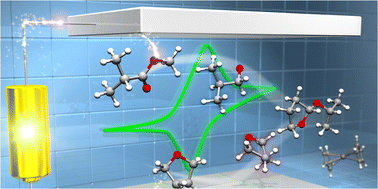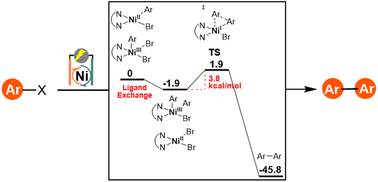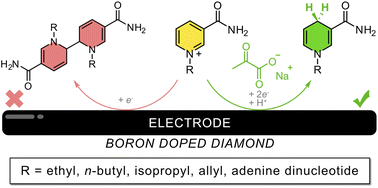Themed collection Electrosynthesis

List of participants
Faraday Discuss., 2023,247, 363-364
https://doi.org/10.1039/D3FD90055J
Poster list
Faraday Discuss., 2023,247, 360-362
https://doi.org/10.1039/D3FD90054A
Concluding remarks: A summary of the Faraday Discussion on electrosynthesis
A summary of the Faraday Discussion presented in this issue and a perspective on that discussion is presented.

Faraday Discuss., 2023,247, 342-359
https://doi.org/10.1039/D3FD00148B
Spiers Memorial Lecture: Old but new organic electrosynthesis: history and recent remarkable developments
Organic electrolytic synthesis is experiencing a second renaissance and is expected to develop more and more as a comprehensive field, focusing on organic synthesis, but also producing the materials necessary to enrich our lives.

Faraday Discuss., 2023,247, 9-33
https://doi.org/10.1039/D3FD00129F
Primary vs. secondary alkylpyridinium salts: a comparison under electrochemical and chemical reduction conditions
For primary and secondary alkylpyridinium salts, trends in ArBr scope are similar, and electrochemical conditions compare well to chemical methods. Our study offers increased understanding in the application of deaminative reductive cross-couplings.

Faraday Discuss., 2023,247, 324-332
https://doi.org/10.1039/D3FD00120B
Self-assembly of random networks of zirconium-doped manganese oxide nanoribbons and poly(3,4-ethylenedioxythiophene) flakes at the water/chloroform interface
A facile water/chloroform interfacial polymerisation was employed to synthesize PEDOT/Zr-K-OMS-2 (PZrK) microscale films (∼21 nm thickness), formed by a random network of PEDOT flakes and Zr-K-OMS-2 nanoribbons.

Faraday Discuss., 2023,247, 227-245
https://doi.org/10.1039/D3FD00077J
Core–shell nanostructured Cu-based bi-metallic electrocatalysts for co-production of ethylene and acetate
A three-compartment alkaline flow-through electrolyser was successfully developed and the single pass conversion of syngas to ethylene achieved was 2.5 mM cm−2 in the optimised conditions.

Faraday Discuss., 2023,247, 216-226
https://doi.org/10.1039/D3FD00058C
Utilisation and valorisation of distillery whisky waste streams via biomass electrolysis: electrosynthesis of hydrogen
Hydrogen production from whisky distillery co-products via digestion with phosphomolybdic acid and electrolysis using proton-exchange membrane flow cells.

Faraday Discuss., 2023,247, 268-288
https://doi.org/10.1039/D3FD00086A
Spatio-temporal detachment of homogeneous electron transfer in controlling selectivity in mediated organic electrosynthesis
Simulations support time dependent detachment of homogeneous ET and coupled chemistry under mediated electroreduction when Eele < EM < EArI.

Faraday Discuss., 2023,247, 302-323
https://doi.org/10.1039/D3FD00089C
Photoelectrocatalyzed undirected C–H trifluoromethylation of arenes: catalyst evaluation and scope
More than a dozen different mediators were employed in the trifluoromethylation of (hetero-)arenes to compare them in their efficacies.

Faraday Discuss., 2023,247, 79-86
https://doi.org/10.1039/D3FD00076A
Mechanistic studies of Ni-catalyzed electrochemical homo-coupling reactions of aryl halides
The formation of a NiII(Ar) intermediate and the NiII(Ar)/NiIII(Ar) ligand exchange pathway to generate a high-valent NiIII(Ar)2 intermediate in Ni-catalyzed electrochemical homo-coupling of aryl halides is reported.

Faraday Discuss., 2023,247, 136-146
https://doi.org/10.1039/D3FD00069A
Selective electrosynthesis of platform chemicals from the electrocatalytic reforming of biomass-derived hexanediol
Efficient electrosynthesis of 6-hydroxyhexanoic acid (6HA) and adipic acid (AA) from the electrochemical oxidation of 1,6-hexanediol using a nanoporous nickel oxyhydroxide-borate anode.

Faraday Discuss., 2023,247, 159-171
https://doi.org/10.1039/D3FD00073G
Exploring electrolyte effects on metal–alkyl bond stability: impact and implications for electrosynthesis
We explore the often neglected impact of supporting electrolyte on homogeneous electrocatalytic mechanisms using the catalytic reduction of benzyl chlorides via Co and Fe tetraphenylporphyrins as a model reaction.

Faraday Discuss., 2023,247, 147-158
https://doi.org/10.1039/D3FD00054K
Electroorganic synthesis in aqueous solution via generation of strongly oxidizing and reducing intermediates
Electrocatalytic reduction of S2O82− in water yields SO4˙−, which is employed for homogeneous oxidation reactions. Highly reducing CO2˙− was electrogenerated via mediated oxidation of C2O42− and utilized for various reductive reactions.

Faraday Discuss., 2023,247, 195-208
https://doi.org/10.1039/D3FD00067B
Electrochemical decarboxylation of acetic acid on boron-doped diamond and platinum-functionalised electrodes for pyrolysis-oil treatment
Tuning the surface of boron-doped diamond functionalised with platinum nanoparticles and thin films alters the selectivity of hydroxyl-radical-mediated indirect electrooxidation of acetic acid to the Kolbe product.

Faraday Discuss., 2023,247, 252-267
https://doi.org/10.1039/D3FD00066D
Effect of [Na+]/[Li+] concentration ratios in brines on lithium carbonate production through membrane electrolysis
Lithium carbonate is crystallized from a complex mixture of Li+, Na+ and K+ chlorides in a water electrolyzer where CO2 is absorbed. The efficiency of the process is studied upon increasing the Na+/Li+ concentration ratios.
![Graphical abstract: Effect of [Na+]/[Li+] concentration ratios in brines on lithium carbonate production through membrane electrolysis](/en/Image/Get?imageInfo.ImageType=GA&imageInfo.ImageIdentifier.ManuscriptID=D3FD00051F&imageInfo.ImageIdentifier.Year=2023)
Faraday Discuss., 2023,247, 101-124
https://doi.org/10.1039/D3FD00051F
Dihydrolevoglucosenone (Cyrene™), a new possibility of an environmentally compatible solvent in synthetic organic electrochemistry
A dihydrolevoglucosenone (DLG)/EtOH mixture resulted in a convenient solvent to carry out galvanostatic electroreductions of starting materials that exhibit high potential value.

Faraday Discuss., 2023,247, 182-194
https://doi.org/10.1039/D3FD00064H
Impact of sodium pyruvate on the electrochemical reduction of NAD+ biomimetics
Aqueous electrochemical reduction of an NAD+ mimetic, 1-n-butyl-3-carbamoylpyridinium bromide, to its enzymatically active form, 1,4-dihydro-1-n-butyl nicotinamide, is favored in the presence of sodium pyruvate as a supporting electrolyte.

Faraday Discuss., 2023,247, 87-100
https://doi.org/10.1039/D3FD00047H
Magnetic field-enhanced redox chemistry on-the-fly for enantioselective synthesis
Redox chemistry on-the-fly in the presence of a magnetic field is proposed as an efficient concept to boost the stereoselective conversion of a prochiral starting compound with the help of autonomous swimmers.

Faraday Discuss., 2023,247, 34-44
https://doi.org/10.1039/D3FD00041A
Electrochemical synthesis of the protected cyclic (1,3;1,6)-β-glucan dodecasaccharide
A protected cyclic (1,3;1,6)-β-glucan dodecasaccharide was synthesized by the electrochemical one-pot dimerisation–cyclisation of a semi-circular hexasaccharide.

Faraday Discuss., 2023,247, 59-69
https://doi.org/10.1039/D3FD00045A
Electrochemical hydrogen isotope exchange of amines controlled by alternating current frequency
Here, we report an electrochemical protocol for hydrogen isotope exchange (HIE) at α-C(sp3)–H amine sites.

Faraday Discuss., 2023,247, 45-58
https://doi.org/10.1039/D3FD00044C
Alkene reactions with superoxide radical anions in flow electrochemistry
Molecular oxygen is used under biphasic electrochemical flow conditions to cleave alkenes.

Faraday Discuss., 2023,247, 297-301
https://doi.org/10.1039/D3FD00050H
Flow cells and reactor design: general discussion
Faraday Discuss., 2023,247, 333-341
https://doi.org/10.1039/D3FD90042H
Materials for electrosynthesis: general discussion
Faraday Discuss., 2023,247, 246-251
https://doi.org/10.1039/D3FD90040A
Electrofuels: general discussion
Faraday Discuss., 2023,247, 289-296
https://doi.org/10.1039/D3FD90041J
Understanding and controlling organic electrosynthesis mechanism: general discussion
Faraday Discuss., 2023,247, 172-181
https://doi.org/10.1039/D3FD90038J
Interdisciplinary electrosynthesis: general discussion
Faraday Discuss., 2023,247, 125-135
https://doi.org/10.1039/D3FD90037A
New strategies in organic electrosynthesis: general discussion
Faraday Discuss., 2023,247, 209-215
https://doi.org/10.1039/D3FD90039H
Selective organic electrosynthesis: general discussion
Faraday Discuss., 2023,247, 70-78
https://doi.org/10.1039/D3FD90036C
About this collection
We are delighted to share with you a selection of the papers associated with a Faraday Discussion on Electrosynthesis. More information about the related event may be found here: http://rsc.li/electrosynthesis-fd2023. Additional articles will be added to the collection as they are published. The final versions of all the articles presented and a record of the discussions will be published after the event.
Organic electrosynthesis initially emerged in the field of synthetic chemistry as an intrinsically green method to replace hazardous chemicals by electrons for oxidations and reductions. In recent years it has been shown to offer unique opportunities to increase conversion efficiencies and synthesize new molecules that are not accessible thermochemically or photochemically and not accessible from petroleum. It can also be used to streamline biocatalysis and chemocatalysis in biorefineries, manufacture chemicals from regional- and community-scale quantities of agricultural waste, and in the pharmaceutical and chemical industries to access fine chemicals in a more efficient and sustainable fashion. Nevertheless, many of these efforts remain exploratory as a fundamental understanding of the elementary processes involved in these transformations is still lacking. This meeting will bring together synthetic chemists, physical chemists, material scientists, electrochemists, computational scientists, and engineers to harness the transformative knowledge required to develop this technology. This meeting will cover 3 main themes: Organic electrosynthesis, Electrofuels and ElectrofuelsFlow cells and reactor design.
On behalf of the Scientific Committee, we hope you join us and participate in this exciting event, and that you enjoy these articles and the record of the discussion.